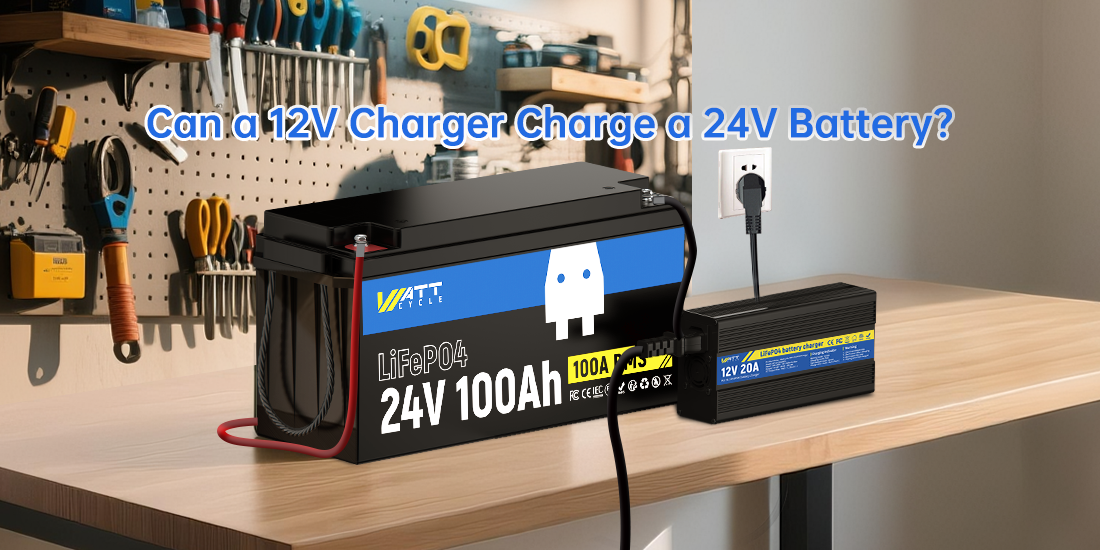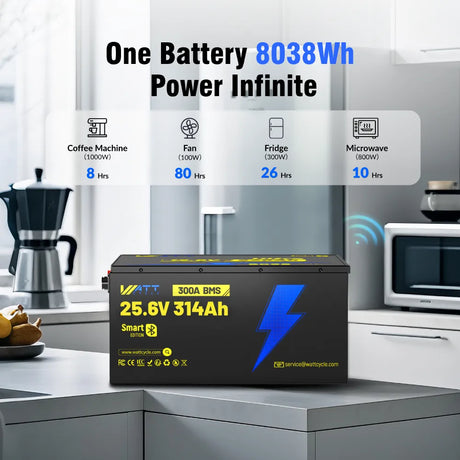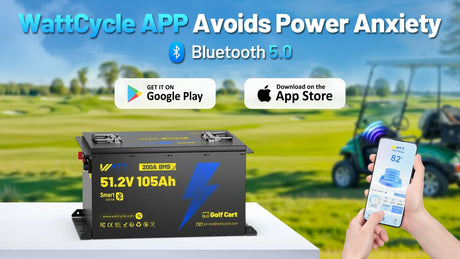No—you can’t fully charge a 24 V LiFePO4 battery with a 12 V charger—leading to incomplete charging, reduced capacity, cell imbalance, and even BMS cut offs. You need a charger rated for the same (or higher) voltage to safely and completely charge your pack.
For owners of deep cycle LiFePO4 batteries, using the right charger isn’t merely about speed—it’s about safety, capacity, and the long life of your investment. A mismatched charger can leave your cells undercharged, trigger the BMS over current protection, or even create heat-related wear over time. Before you hook up that 12 V charger to your 24 V pack, it’s essential to understand why matching voltage is the first rule of battery care—and how WattCycle’s line of purpose-built chargers keeps you powered without compromise.
What voltage means in practical terms
Voltage is the electrical “push” that moves current through your LiFePO4 cells, much like water pressure driving flow through a hose. In battery systems, it tells you how much potential energy is available for your devices or motor. Simply put, higher voltage delivers more power to run bigger loads or charge faster—provided the charger and pack are matched. When you shop for a LiFePO4 battery charger, you’re really choosing how much electrical pressure you’ll put into your battery.
Difference between 12V and 24V systems
A 12 V system is the most common on cars, small RVs, and modest solar setups—it uses a single 12 V battery or bank. A 24 V system doubles that pressure by wiring two 12 V batteries in series, making it a go-to for larger marine crafts, heavier off-grid rigs, and some electric vehicles. The higher voltage lets you push more power through the same wires with less current, reducing heat and improving efficiency. That’s why a dedicated 24 V lithium battery charger is recommended when you run a two-battery series bank.
Series vs. parallel connections in LiFePO4 battery packs
Series (voltage increase): Batteries lined end-to-end (– to +) stack their voltages (12 V + 12 V = 24 V) while capacity (Ah) stays the same.
Parallel (capacity increase): Batteries joined positive to positive and negative to negative keep voltage the same (e.g., 12 V) but add capacity (Ah) together.
Series wiring is how you build a true 24 V bank, and it demands a charger rated for 24 V output. Mixing up series and parallel setups without the proper charger—say, trying to use a 12 V lithium battery charger on a series-wired 24 V pack—leads to undercharging and risks to your BMS and cells.

Why a 12V Charger Alone Can’t Fully Charge a 24V Battery
Insufficient voltage headroom and charging thresholds
A standard 12 V lithium battery charger simply doesn’t reach the higher voltage needed to push your 24 V bank all the way to full. LiFePO4 cells require about 3.6 V to 3.65 V per cell at absorption (approximately 29V for a 24 V pack), while a 12 V charger tops out around 14.6 V. That gap means the charger maxes out well below the battery’s target, leaving cells undercharged and reducing usable capacity.
Impact on state-of-charge and BMS regulations
When voltage never climbs to the absorption point, your battery management system (BMS) will log an incomplete state-of-charge (SOC) and may even refuse to balance cells. Incomplete charging can cause long-term imbalance, where some cells remain perpetually low while others stay high—eventually triggering BMS over current or low-voltage cut-off protections. This mismatch stresses the pack and undermines the protections built into your quality LiFePO4 battery charger.
charging curve for a 24V LiFePO4 battery vs. a 12V LiFePO4 battery charger
A proper 24 V lithium battery charger ramps through bulk (constant current) up to around 29 V, then switches to absorption before tapering in float. In contrast, a 12 V charger will bulk-charge to roughly 14.4 V, plateau immediately, then drop to float—never advancing the pack beyond half its true potential. Visualizing both curves highlights why a 12 V charger can’t finish the job on a 24 V bank: it simply lacks the voltage headroom to push cells into full absorption and balance.

Risks of Mismatched Charging
Incomplete charging and capacity loss
When you try to top up a 24 V pack with a 12 V LiFePO4 battery charger, the cells never reach their full absorption voltage. Over time, this under-charging reduces the pack’s usable amp-hours and shortens runtime. Your deep cycle bank may seem serviceable at first, but you’ll gradually lose capacity—and the true depth of charge will drop below the BMS balance threshold.
Potential BMS over-current or over-voltage protection triggers
A quality lithium battery charger works hand-in-hand with the pack’s BMS to guard against extremes. If voltage never climbs high enough, some BMS architectures interpret that as a fault and disable charging to protect cells. Conversely, any attempt to “force” more current into a mismatched pack can trip over-current or over-voltage cut-offs—leaving you stranded until the system resets.
Heat buildup, cell imbalance, and long-term damage
Running a 12 V charger past its intended range stresses internal components and the cells themselves. Imbalanced cells generate heat during both charge and discharge, accelerating wear on the LiFePO4 chemistry. Over months of repeated mismatch, you risk permanent cell degradation—a slow path to capacity fade and, ultimately, battery replacement.

Safe Workarounds: When You Have Only a 12V Charger
Series-charging two 12 V batteries (and why it’s not ideal)
You can wire two 12 V deep cycle batteries in series (– to +) to create a 24 V bank, then use your 12 V charger on each battery individually by disconnecting the series link. While this lets you fully charge both cells, it’s time-consuming and risks imbalance if one battery holds less capacity. Plus, repeatedly re-configuring your pack adds wear to terminals and cables—far from the convenience of a specifically designed for 24 V LiFePO4 battery charger.
Using a DC-DC step-up converter with your 12 V lithium battery charger
A DC-DC boost converter can raise your 12 V charger’s output up to the ~29 V needed for a 24 V LiFePO4 battery pack. You simply connect the 12 V LiFePO4 battery charger to the converter input and adjust the output to match your bank’s absorption voltage. While this approach automates the step-up, it adds complexity and cost—plus you’ll need to verify that both converter and charger support LiFePO4 charging profiles to avoid over-voltage or triggering BMS over-current protection.
Importance of real-time monitoring and voltmeter checks
No workaround is foolproof without vigilant monitoring. Always hook up a reliable voltmeter or Bluetooth-enabled gauge during charge cycles to track per-cell voltage and overall pack voltage. Watch for any cell drifting more than 0.05 V apart—an early sign of imbalance. Regular checks help you catch temperature spikes or BMS cut-offs before they harm your battery bank or cut short your outing.
Choosing the Right Lithium Battery Charger for 24V Packs
When shopping for a 24 V lithium battery charger, the first box to tick is precise voltage matching: you need a charger that delivers a full absorption voltage around 29–29.4 V to complete the charge cycle on a 24 V pack. Next, pick an output current that balances speed and cell health—typically 10–20% of your pack’s amp-hour rating (for a 100 Ah bank, a 10–20 A charger). Finally, ensure the charger follows a LiFePO4 battery charger profile: constant-current (bulk), constant-voltage (absorption), and a safe float or cutoff stage that protects the BMS from over-voltage stress.
Why WattCycle’s 24V Lithium Battery Charger Stands Out
WattCycle’s dedicated lithium battery charger is built from the ground up for deep cycle LiFePO4 cells. With a smart BMS-aware algorithm, it automatically shifts from bulk to absorption to float, preserving cell balance and extending cycle life. Ruggedized for marine and off-grid use, our charger resists vibration and moisture, so it stays reliable whether it’s mounted under your helm or in a remote cabin.

Bluetooth-Enabled Monitoring for Peace of Mind
No more guessing games about charge status—WattCycle’s Bluetooth monitoring pairs with our free app to show real-time voltage, current, and temperature data straight on your phone. You can set custom alerts for high or low voltage thresholds, track historical charge cycles, and even share logs with technicians for troubleshooting. It’s the easiest way to keep your 24 V LiFePO4 battery pack happy and your adventures uninterrupted.
Best Practices to Protect Your LiFePO4 Battery
Match charger voltage to your pack
Always pair a charger that exactly matches your battery’s voltage. For a 24 V LiFePO4 battery pack, use a specifically designed for LiFePO4 24 V lithium battery charger—never improvise with a 12 V charger or generic power supply. Correct voltage ensures your BMS balances cells properly, maximizes run time, and prevents under- or over-charging that can erode capacity.
Monitor temperature and voltage per cell
LiFePO4 chemistry thrives within a narrow temperature window (typically 32 °F to 113 °F). During charging and discharging, track both pack temperature and individual cell voltages. Consider a Bluetooth-enabled LiFePO4 battery charger or inline voltmeter so you can catch hot spots or drifting cell voltages early—before they trigger protective cut-offs or permanent cell imbalance.
Rely on trusted brands with robust BMS protection
Your battery’s long-term health hinges on a quality Battery Management System. Choose deep cycle LiFePO4 batteries equipped with BMS over-current protection, low-temperature cutoff, and cell-balancing features. WattCycle’s LiFePO4 battery charger line.
Conclusion
Now that we’ve seen why a lower‑voltage charger can’t top up a higher‑voltage pack—leading to incomplete charging, reduced capacity, cell imbalance, and even BMS cut‑offs—you might be asking: what about the reverse? Can you charge a 12 V battery with a 24 V charger?










1 comment
Knowing all this, and I conversed my 24v system, why would you knowingly sell me a “father’s day sale” that not only represents false advertising visual 2 batteries and selling 1 (fine print) but included a 12v. Charger inadequate to use on my system, but also after further correspondence allowing me to purchase this “sale” twice at over 200$ above standard purchase price and double the unusable equipment? All with documented correspondence beforehand! Complete irresponsible corruption. Now my system controlling my water supply has been down for 2 week’s and all because of your inconsiderate greed. Now you tell me it’s up to me to facilitate the return of this debacle of your making! My trust in your integrity is zero. The only way to fix this situation is for you to accept the return of the 2 12v. Chargers and send me 2 24v. Chargers as I have already purchased 6 of your 12v 100ah batteries, 2 from your (sale) at 279$ each and 4 from Allebaba at 505$ of the 12 that must be replaced.